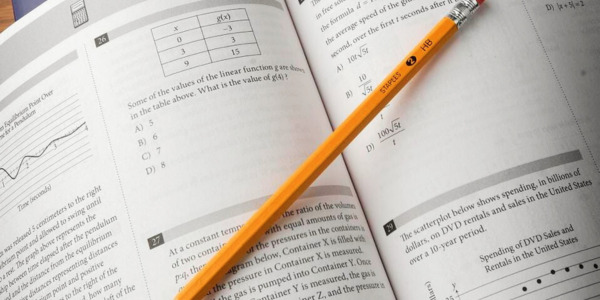Tips To Ace SAT Test
The SAT is one of the most prominent and widely recognized standardized tests for international students pursuing higher education. The College Board has supervised and administered this examination since its inception. Formerly known as the Scholastic Aptitude Test (SAT), it was renamed the Scholastic Assessment Test and is now referred to simply as the SAT. The SAT assesses and evaluates the verbal, written, and mathematical skills of students or prospective students who wish to pursue studies abroad.
In many countries, including the United States, the United Kingdom, and Canada, SAT scores are a primary requirement for admission to universities and other institutions of higher education, so they are of great importance to students seeking to pursue higher education.
Throughout its history, the SAT exam has been known by a variety of different names. Its original name was the Scholastic Aptitude Test, then it was renamed the Scholastic Assessment Test (SAT I: Reasoning Test), and then it was shortened to SAT. Despite these name changes, its primary focus remains consistent: measuring the ability of test-takers to analyze and solve problems. These abilities are typically acquired through formal education and are essential on college campuses.
Function:
The SAT functions as an entrance exam for students who wish to pursue higher education abroad, particularly at universities and colleges in the United States and Canada. It is a paper-and-pencil exam used to evaluate the mathematical reasoning and language skills of applicants. The universities to which you apply will evaluate your SAT scores during the admissions procedure. These scores frequently play a crucial role in scholarship decisions.
Previously, students could also demonstrate their proficiency in specific subjects by taking SAT Subject Tests. It is essential to note, however, that the SAT Subject Tests have been discontinued as of 2021. This highlights the significance of thorough preparation and a comprehensive comprehension of the SAT as a crucial first step for students who wish to pursue studies abroad.
1. Understand the Format of the SAT Test
The first step to ace the SAT test is to understand its format. The SAT test consists of four sections: Reading, Writing and Language, Math with a calculator, and Math without a calculator. Additionally, there is an optional essay section. Each section is timed, and the entire test takes about three hours (excluding the optional essay section). Familiarizing yourself with the test format and timing will help you manage your time more efficiently during the test.
Multistage Adaptive Testing (MST) is the structure of the SAT exam.
The SAT Suite digital assessment utilizes multistage adaptive testing (MST) methodology. Since nearly 40 years ago, adaptive testing has been a common method in large-scale digital standard assessments.
In the multistage adaptive testing format of the SAT Suite, each section of the test, including Reading & Writing and Mathematics, is divided into two stages of equal duration and distinct scheduling, each of which consists of question modules.
As depicted in Figure 1, the procedure proceeds as follows:
Module 1: Students commence each test section by answering a series of questions in the first module. This module contains questions of varying levels of difficulty, including simple, moderate, and difficult questions. Before moving on to the second module, the purpose of this module is to provide students with the opportunity to demonstrate their initial accomplishments.
Based on their performance in the first module, the questions in the second module are meticulously tailored to each student’s level of achievement. These questions are either more or less challenging than the questions in the first module. In other words, the exam “adapts” to present queries that correspond with each student’s performance level more closely.
By utilizing this methodology, SAT Suite is able to provide a more accurate and pertinent assessment for each student, ensuring that they are appropriately challenged by the exam. This makes assessment more equitable and allows students to demonstrate their potential more effectively.
2. Create a Study Plan
Preparing for the SAT test requires a structured study plan. Start by setting a realistic goal for your score, and then create a study schedule that allows you to reach that goal. Break down your study sessions into smaller, manageable chunks and make sure to set aside time for practice tests.
How to Develop Your SAT Study Strategy
Possessing an effective SAT study plan is your secret weapon for passing the SAT. Tailoring your study plan to your lifestyle and schedule will enable you to put in the time and discipline you need to earn a desirable SAT score.
Learn the Content of the SAT
One of the most essential things you can do prior to beginning your SAT preparation is to familiarize yourself with the types of questions that will be asked.
Not only should you review the correct SAT answers, but you should also review the questions themselves! This will ensure that you comprehend the question thoroughly and can provide the best answer feasible.
You can begin by researching sample tests and sample queries to determine the nature of the examination. This way, there will be no surprises on the day of your exam.
Noting that the SAT questions alter minimally from year to year is essential. Consequently, the subject matter remains unchanged. Therefore, the more SAT practice tests you take, the better you will understand the material!
Evaluate Your Capabilities in Advance
Nobody is more aware of your assets and weaknesses than you are. It is important to comprehend these when developing a SAT study plan so that you can allocate sufficient time to study and strengthen your skills. The most effective method is to take a PSAT or a practice test.
Writing a PSAT will give you a general idea of which sections of the test come effortlessly to you and which ones require more time and effort. Thus, you can customize your SAT study plan to devote more time to the subjects you find difficult while focusing on your assets.
For instance, if you already find math difficult, you may find both math sections of the SAT to be challenging. Self-testing allows you to identify problem areas and devote more time to reviewing math questions in preparation for the SAT.
Evaluate your PSAT score and make a note of it; you’ll want to compare your scores each time you take the PSAT to determine if you’re improving.
Understand Your Study Methods
It is also essential to evaluate your personal “study skills” and how you comprehend concepts and solve problems. Consider whether you work best in a study group or in an environment where you can solve problems aloud, or whether you prefer to study alone.
Regardless of the situation, knowing and comprehending your preferred, individualized method of study will aid you in developing a SAT study plan.
Practice, Exercise, Exercise
Unavoidably, the key to achieving a high SAT score is the amount of time spent practicing. Rome wasn’t constructed in a day, and neither is a perfect SAT score!
It is recommended that you begin studying for the SAT at least six months in advance; that way, you will have a great understanding of what to expect, and your answers will continue to improve with practice. If you do not have six months, you will need to modify your study schedule and devote more hours per week to studying.
There is nothing worse than running out of time on a test, and you don’t want this to happen on the day you take the SAT. Nonetheless, devote time and effort to test preparation.
Not only will you have superior answers, but you will also be able to respond more quickly and effectively. This will allow you more time to examine and verify your answers after completion.
In the end, you cannot study enough for the SAT; however, how can you maximize the time you have? The solution is to adhere to a six-, three-, or one-month SAT study timetable.
The conclusion
Developing an effective SAT study plan is essential for success. Understanding the SAT’s content and format, evaluating your strengths and weaknesses, and adapting your study methods to your learning approach are all essential steps. However, consistent practice and commitment are crucial. You can significantly improve your SAT scores and open doors to exciting educational opportunities with the proper strategy and effort.
3. Focus on Your Weaknesses
Identifying your weaknesses and focusing on them is key to improving your SAT test score. Use your practice test results to pinpoint areas where you need to improve, and then spend extra time studying those topics.
4. Practice with Official SAT Practice Tests
One of the best ways to prepare for the SAT test is to practice with official SAT practice tests. These tests are created by the same organization that administers the SAT test, so they are a reliable way to assess your readiness. Practice tests help you identify your weaknesses and strengths, allowing you to focus your study efforts more effectively.
Book recommendation for SAT test
The New SAT: 1,500+ Practice Questions from Tutorverse
This book contains over 1,500 practice questions that can be readily printed for study purposes. Each practice question comes with detailed explanations, helping you comprehend the concepts and relevant skills needed to assess your strengths and weaknesses effectively.
The book includes a review of grammar, sample responses, extensive practice exams, and essay practice questions. The book’s practice queries are organized by difficulty level. Therefore, the more difficult the questions you attempt, the more comprehensively you will be prepared for the SAT.
The College Panda’s SAT Mathematics
The following SAT guide is “College Panda’s SAT Math: Advanced Guide and Workbook for the New SAT.” This book is particularly helpful for those who struggle with SAT mathematics.
The exhaustive SAT Math guide covers all the necessary SAT Math concepts you need to know in order to excel on the exam, from the most basic quantitative skills to the most complex. It contains over 500 practice questions with thorough explanations to help you overcome your math-related deficiencies.
Best Guide to the SAT Essay
Despite the fact that the SAT essay is presently optional, it is still required by many top schools and scholarship programs. This book provides an exhaustive overview of this section. It provides essay templates that are adaptable to various SAT essay prompts. In addition, it contains an analysis section designed to enhance your confidence in effectively addressing essay prompts.
These three books are valuable resources for SAT preparation, as they cover a variety of test topics and provide thorough practice questions and explanations. Depending on your assets and weaknesses, you may find one or more of these SAT preparation books particularly useful.
If you’re struggling to prepare for the SAT test, consider joining a study class or private tutoring led by skilled tutors at various SAT prep institutions available in Jakarta. One SAT prep institution that you can consider is Ultimate Education. The SAT class or private tutoring program will help you better understand the material and provide the right strategies to tackle the SAT test.
5. Learn Test-Taking Strategies
Learning test-taking strategies can help you approach the SAT test with confidence. For example, when answering multiple-choice questions, use the process of elimination to narrow down your options. Additionally, for the math sections, try plugging in answer choices to quickly identify the correct answer.
6. Take Care of Yourself
Taking care of yourself is an often-overlooked aspect of test preparation. Make sure to get plenty of sleep, eat well, and exercise regularly. Being well-rested and energized can help you focus and stay alert during the test.
7. Find Information on College Score Policies
Find out the score policy of the college you want to enter. Some colleges may pay more attention to certain SAT scores, while others may pay attention to your average score or focus on extracurricular activities. So, remember to do thorough research!
FAQs
How long should I study daily for the SAT?
It is recommended to study for a minimum of two to three hours per day, but the precise amount depends on your schedule and objectives.
Is it necessary to take the PSAT prior to SAT preparation?
Although it is not required, completing the PSAT can help you identify areas for improvement and customize your study plan.
Should I prepare alone for the SAT or join a study group?
Depending on your inclinations, you can choose to study alone or in a group. Some find group study beneficial for discussion, while others favor individual study for concentration.
When should I begin SAT preparation?
Start your SAT preparation at least six months prior to your intended test date to allow sufficient time for in-depth study and practice.
How can I maintain motivation while preparing for the SAT?
Set attainable objectives, reward yourself for achieving them, and keep in mind the long-term benefits of a high SAT score to maintain motivation.
In order to successfully take the SAT test, you must prepare yourself well and accurately. One way you can do this is by joining one of Ultimate Education’s SAT preparation program that will be taught by experienced and certified tutors. So, what are you waiting for? Register now to improve your English language skills if you plan to continue your studies abroad, especially in the United States.








